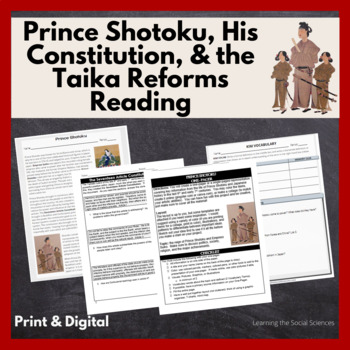Prince Shotoku, 17 Article Constitution, & Taika Reforms Reading & One-Pager
Learning the Social Sciences
1.3k Followers
Grade Levels
7th - 12th
Subjects
Resource Type
Standards
CCSSRI.9-10.1
CCSSRH.9-10.1
CCSSRH.9-10.2
Formats Included
- Zip
Pages
5 pages
Learning the Social Sciences
1.3k Followers
What educators are saying
We really enjoyed these articles. Students were able to gain more knowledge about the topics discussed.
Also included in
- This unit bundle covers the history of Asia from 500 to 1650. I start with China during the Sui Dynasty and then cover the Tang, Song, Yuan, and Ming Dynasties. I also cover the major dynasties of Korea (Koryo, Silla, and Chosen), the history of Japan through the feudal age to the Tokugawas. I thPrice $16.99Original Price $32.02Save $15.03
Description
This reading starts with a one-page biography on Prince Shotoku and what he did for Japan during his regency. There are questions and vocabulary terms and an answer key is included.
Next is a page with excerpts from the Seventeen Article Constitution with questions.
Finally, there is a short summary about how the Taika Reforms of 645 CE in Japan came to being and what they enacted. It then has 3 articles from the document for students to read and interpret.
Multiple Formats: The reading comes as a PDF, Microsoft Document, and Google Document. The reading is editable! The link to the Google version is in the key of the other versions.
Great for Distance Learning!
Total Pages
5 pages
Answer Key
Included
Teaching Duration
N/A
Report this resource to TPT
Reported resources will be reviewed by our team. Report this resource to let us know if this resource violates TPT’s content guidelines.
Standards
to see state-specific standards (only available in the US).
CCSSRI.9-10.1
Cite strong and thorough textual evidence to support analysis of what the text says explicitly as well as inferences drawn from the text.
CCSSRH.9-10.1
Cite specific textual evidence to support analysis of primary and secondary sources, attending to such features as the date and origin of the information.
CCSSRH.9-10.2
Determine the central ideas or information of a primary or secondary source; provide an accurate summary of how key events or ideas develop over the course of the text.




